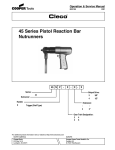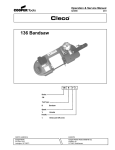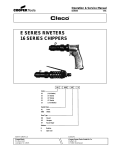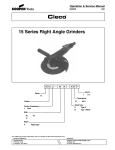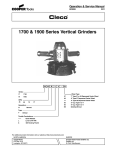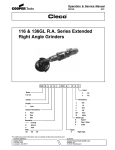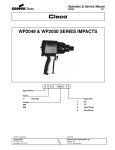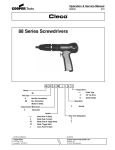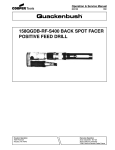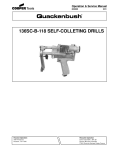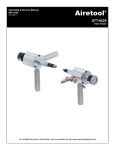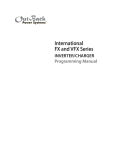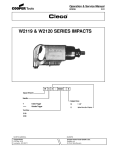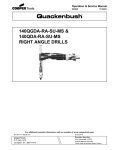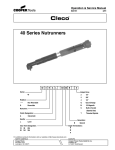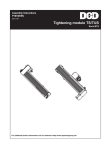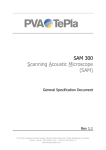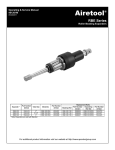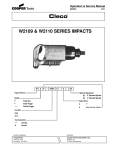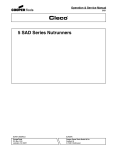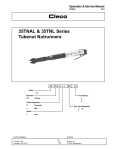Download warning
Transcript
Operation & Service Manual 823049 6/01 CH SERIES CHIPPERS CH - - XX - X XX Series: CH Stroke: 22 2 1/4 32 3 1/4 Nose Type : RD Round HX Hexagon Retainer : H Standard for CH Models Only C Cleco Type for CH Models Only Q Quick Change for CH Round Collar Chisels Only NORTH AMERICA EUROPE CooperTools P.O. Box 1410 Lexington, SC 29071 Cooper Power Tools GmbH & Co. Postfach 30 D-73461 Westhausen 1 Safety Recommendations For your safety and the safety of others, read and understand the safety recommendations before operating any percussion tool. Always wear protective equipment and clothing. ! WARNING Impact resistant eye protection must be worn while operating or working near this tool. throttle moves freely and returns to closed position). Being careful not to endanger adjacent personnel, clear the air hose of accumulated dust and moisture. Attachment of a quickdisconnect air coupling directly to the inlet threads of a percussion tool can cause wear and failure of the coupling. Should the coupling fail, severe injury can result from the hose end violently whipping about. If a quick-disconnect air coupling is used, separate the coupling from the tool with a whip hose (1.5 feet minimum). Only use a whip hose with fittings of hardened steel or other material which is at least comparably resistant to shock. Do not use hose to lift or lower tool. For additional information on eye protection, refer to Federal OSHA Regulations, 29 CFR, Section 1910.133, Eye and Face Protection, and ANSI Z87.1, Occupational and Educational Eye and Face Protection. This standard is available from the American National Standards Institute, Inc., 11 West 42nd Street, New York, NY 10036. ! CAUTION Personal hearing protection is recommended when operating or working near this tool. Hearing protection is recommended in high noise areas (above 85 dBA). Close proximity of additional tools, reflective surfaces, process noises, and resonant structures can substantially contribute to the sound level experienced by the operator. For additional information on hearing protection, refer to Federal OSHA Regulations, 29 CFR, Section 1910.95, Occupational Noise Exposure, and American National Standards Institute, ANSI S12.6, Hearing Protectors. Gloves and other protective clothing should be worn as required. Properly fitted gloves cushion vibration and protect the fingers from pinching, scuffing and scraping and must be used when guiding the chisel on a workpiece. ! WARNING Compressed air hazard. Compressed air can cause loss of eyesight, bleeding or injection of foreign material into the body or blood. Never use compressed air to clean off clothing or direct it at any person. Cleco percussion tools are designed to operate on 90 psig (6.2 bar) maximum air pressure. Excessive air pressure can damage the plunger and increases sound levels. Installation of a filter-regulator-lubricator in the air supply line ahead of the tool is highly recommended. Before the tool is connected to the air supply, check the throttle for proper operation (i.e., 2 Whip Hose Coupling Nipple Coupling Nipple Quick Disconnect Coupling Do not use! Quick Disconnect Coupling OK Cracked chisels or implements are hazardous. Visually inspect the chisel or implement for cracks before use. Make a practice of having all chisels magnifluxed before resharpening. Destroy and discard any chisel or implement that shows a crack. ! WARNING ! WARNING Explosive Hazard. Use only nonsparking chisels or implements in explosive or flammable environments. Correct selection of the chisel or other implement is important. Dull edges on the chisel or moil point cause the energy of the percussion blow to be absorbed by the tool itself, instead of the workpiece, increasing the chance of chisel breakage. When operating percussion tools in explosive or flammable environments, use only non-sparking chisels or implements such as those made from beryllium copper. Also, do not use cupped rivet sets with Cleco percussion tools to drive nails. Blows not centered on the nail can cause the nail to ricochet off the work and strike the user. ! WARNING Impact Hazard. Ejected chisels can cause serious injury or even death. Disconnect air before changing chisels. Do not operate unless chisel is in contact with workpiece. Do not point tool in direction of any person. Use safety retainers on tool and retainer type chisels. Erect barriers to protect persons in surrounding or lower work areas. Before removing a tool from service, after completing a job, or changing chisels or other bits, make sure the air line is shut off and drained of air. This will prevent the tool from operating if Safety Recommendations the throttle is accidently engaged. Use of a self-relieving valve within reach of the user of the tool is highly recommended. INDIVIDUAL WORK STATION Self-Relieving Valve Regulator Lubricator 0 45 90 Coupling Filter Hose Quick Disconnect Coupling Tool Do not operate or trigger any percussion tool unless the chisel, scaling tool, rivet set, or other implement is in the tool and in contact with the workpiece or worksurface. Never point any percussion tool in the direction of another person or yourself, or deliberately eject a chisel. Failure to do so can cause serious injury and/or damage the tool. Chisel or rivet set retainers are recommended and furnished as standard equipment. Periodic inspection of the retainer for wear or damage is recommended since these devices can receive heavy abuse, particularly if the tool is run off the workpiece. Damaged retainers are dangerous, and can allow the ejection of a chisel or other implement. They must be replaced as necessary. Only use safety retainer type chisels, as shown in the operating instructions and service manual. Also, it is good safety practice to erect suitable barriers to protect persons in surrounding or lower work areas from possible ejected tools. Some individuals may be susceptible to disorders of the hands and arms when performing tasks Repetitive work motions and/or vibration consisting of may cause injury to hands and arms. highly repetitive Use minimum hand grip force. Keep body and hands warm and dry. motions and/or Avoid anything that inhibits blood circulation. exposure to exAvoid continuous vibration exposure. tended vibration. Keep wrists straight. Avoid repeated bending of wrists and hands. Cumulative trauma disorders such as carpal tunnel syndrome and tendonitis may be caused or aggravated by repetitious, forceful exertions of the hands and arms. Vibration may contribute to a condition called Raynaud’s Syndrome. These disorders develop gradually over periods of weeks, months, and years. It is presently unknown to what extent exposure to vibrations or repetitive motions may contribute to the disorders. Hereditary factors, vasculatory or circulatory problems, exposure to cold and dampness, diet, smoking and work practices are thought to ! WARNING contribute to the conditions. Any user suffering prolonged symptoms of tingling, numbness, blanching of fingers, clumsiness or weakened grip, nocturnal pain in the hand, or any other disorder of the shoulders, arms, wrists, or fingers is advised to consult a physician. If it is determined that the symptoms are job related or aggravated by movements and postures dictated by the job design, it may be necessary for the employer to take steps to prevent further occurrences. These steps might include, but are not limited to, repositioning the workpiece or redesigning the workstation, reassigning workers to other jobs, rotating jobs, changing work pace, and/ or changing the type of tool used so as to minimize stress on the operator. Some tasks may require more than one type of tool to obtain the optimum operator/tool/task relationship. BAD POSTURE GOOD POSTURE • Tasks should be performed in such a manner that the wrists are maintained in a neutral position, which is not flexed, hyperextended, or turned side to side. • Stressful postures should be avoided. Select a tool appropriate for the job and work location. Work gloves with vibration reducing liners and wrist supports are available from some manufacturers of industrial work gloves. Tool wraps and grips are also available from a number of different manufacturers. These gloves, wraps, and wrist supports are designed to reduce and moderate the effects of extended vibration exposure and repetitive wrist trauma. Since they vary widely in design, material, thickness, vibration reduction, and wrist support qualities, it is recommended that the glove, tool wrap, or wrist support manufacturer be consulted for items designed for your specific application. Proper fit of gloves is important. Improperly fitted gloves may restrict blood flow to the fingers and can substantially reduce grip strength. This information is a compilation of general safety practices obtained from various sources available at the date of production. However, our company does not represent that every acceptable safety practice is considered herein, or that abnormal or unusual circumstances may not warrant or require additional procedures. Your work may require additional specific safety procedures. Follow these procedures as required by your company. For more information, see the latest edition of ANSI B186.1, Safety Code for Portable Air Tools, available from the American National Standards Institute, Inc., 11 West 42nd Street, New York, NY 10036. 3 ! WARNING Eye protection must be worn when disassembling tool or when air line is turned on. A self-relieving valve in close proximity to the repair station to bleed off air is recommended. OPERATING INSTRUCTIONS The CLECO "CH" series chipper is designed to operate on 90 psig air pressure using a 1/2" I.D. hose up to 8' in length. If additional length is required, a 3/4" I.D. or large hose should be connected to the 1/2" hose. If the operation of the chipper becomes sluggish or erratic, pour one teaspoon of kerosene into the air inlet and operate the tool for a few seconds. Lubricate the tool as explained above after flushing. The air hose should be cleared of accumulated dirt and moisture, then one-half (1/2) teaspoon of 10W machine oil should be poured into the tool's air inlet before connecting the hose to the tool. STORAGE In the event that it becomes necessary to store the tool for an extended period of time (overnight, weekend, etc.), it should receive a generous almount of lubrication at that time and again when returned to service. Store the tool in a clean and dry environment. Alternatively, chippers and scalers may be put in a bucket of kerosene or light oil for extended periods of storage such as weekends or plant shutdowns. The tool should always be lubricated before storage and when being returned to service. Important: The handle should be checked after the first eight hours of operation and occasionally thereafter to make sure it is tight. Torque to 300 ft. lbs. LUBRICATION An automatic in-line filter-lubricator is recommended as it increases tool life and keeps the tool in sustained operation. The in-line lubricator should be regularly checked and filled with a good grade of 10W machine oil. Never use a heavy oil, as this will cause a loss of efficiency. Proper adjustment of the in-line lubricator is performed by placing a sheet of paper next to the exhaust ports and holding the throttle open for approximately 30 seconds. The lubricator is properly set when a light stain of oil collects on the paper. Excessive amounts of oil should be avoided. CHISEL INSTALLATION & REMOVAL Turn off the air and drain the air ! WARNING hose before installing or removing any chisel or implement. Follow the procedure below and on next page for installing any chisel or implement. Reverse the procedure for removal. STANDARD RETAINER CHISEL INSERT CHISEL INTO RETAINER AND ROTATE RETAINER 1/4 TURN (90°) IN EITHER DIRECTION. INSTALL RETAINER WITH CHISEL ONTO BARREL WHILE ALIGNING SLOT IN RETAINER WITH GROOVE ON BARREL. RETAINER GROOVE BARREL SLOT LOCK SPRING INSERT SPRING INTO SLOT IN RETAINER UNTIL ONLY TAB ON SPRING IS EXPOSED. 4 TAB OPTIONAL QUICK CHANGE RETAINER FOR ROUND COLLARED CHISEL ONLY OPTIONAL CLECO TYPE RETAINER INSTALL RETAINER ON BARREL. ALIGN SLOT IN RETAINER WITH GROOVE ON BARREL. INSTALL RETAINER ONTO BARREL WITH SLOT IN RETAINER AND GROOVE ON BARREL IN ALIGNMENT. BARREL BARREL GROOVE SLOT RETAINER RETAINER SLOT INSERT SPRING INTO SLOT IN RETAINER UNTIL ONLY TAB ON SPRING IS EXPOSED. CHISEL RELEASE COLLAR GROOVE LOCK SPRING LOCK SPRING INSERT SPRING INTO SLOT IN RETAINER UNTIL ONLY TAB ON SPRING IS EXPOSED. TAB INSERT CHISEL INTO RETAINER UNTIL LATCH SPRING RISES. ROTATE CHISEL 1/4 TURN (90°) IN EITHER DIRECTION. PULL RELEASE COLLAR BACK AND INSERT CHISEL. CHISEL RELEASE COLLAR SHOULD RETURN TO ORIGINAL LOCATION WHEN COLLAR OF CHISEL IS BEHIND BALLS IN RETAINER. RETAINER AND CHISEL ARE NOW LOCKED INTO POSITION. ! WARNING TAB Eye protection must be worn when disassembling tool or when air line is turned on. A self-relieving valve in close proximity to the repair station to bleed off air is recommended. SERVICE INSTRUCTIONS DISASSEMBLY REASSEMBLY To disassemble the tool, place the flats of the barrel in a vise with the handle, No. 833157, facing upward. Using a pair of spreader pliers, spread the exhaust deflector, No. 834674, open and slip it down on the barrel far enough to allow the handle locking ring to be disengaged from the handle. Unscrew the handle from the barrel and remove the valve block button, No. 832172, valve, No. 832195, and valve block, No. 832506. Remove the barrel from the vise and invert it, allowing the plunger to fall out. To disassemble the throttle valve, unscrew throttle valve cap, No. 833155, and remove the throttle valve spring, No. 834852, and throttle valve, No. 834854. Throttle valve pin, No. 834853, will drop out of throttle valve pin bushing, No. 832210. The tool is reassembled in the reverse order of disassembly. Wash all parts thoroughly in a solvent before reassembly. Prepare the threads on the barrel and in the handle with a high grade thread lubricant before assembling. Make sure the threads are clean before lubricating. The handle, No. 833157, should be torqued to 300 ft. lbs. After reassembly, place teaspoon of 10W machine oil in the handle bushing before attaching the air hose. This will insure immediate lubrication of all parts as soon as the air is applied. After the air hose is connected to the tool and the air supply turned on, there should be a slight amount of free play in the throttle lever, No. 834855, lack of which will allow the tool to run without being throttled. If no free play is evident, the flat end of the throttle valve pin should be ground off until there is a small amount of free play in the throttle lever. Remove handle bushing, No. 833471, and wash the inlet screen in a solvent. Blow air through the screen in reverse of normal air flow to remove any foreign matter. If the screen is torn or damaged, it should be replaced. 5 "CH" SERIES CHIPPER RETAINERS STANARD RETAINER - 833163 833163 839033 OPTIONAL CLECO TYPE RETAINER - 831847 834776 834774 834775 839033 QUICK CHANGE RETAINER FOR ROUND COLLAR CHISEL ONLY - 831861 834872 834874 PART NO. 833163 834774 834775 834776 834871 834872 834873 834874 834875 834876 834877 839033 834873 834876 NAME OF PART Standard Retainer (incl. 839033) Optional Cleco Type Retainer Optional Cleco Type Latch Spring Optional Cleco Type Latch Optional Quick Change Retainer Body Optional Quick Change Retainer Sleeve Optional Quick Change Retainer Spring Optional Quick Change Retainer Release Collar Optional Quick Change Retainer "O"-Ring Optional Quick Change Retainer Ball Optional Quick Change Retainer Lock Spring Standard and Optional Cleco Type Retainer Lock Spring The Retainer subassemblies can be purchased using these Part Numbers: Standard Retainer — 833163 Optional Cleco Type Retainer — 831847 Optional Quick Change Retainer for Round Collar Chisel Only — 831861 6 834877 834871 834875 QTY. 1 1 1 1 1 1 1 1 1 6 1 1 7 PART NO. 203185 203419 832125 832172 832195 832210 832215 832506 832540 832726 832964 832965 833155 833157 833471 834276 834293 834674 834852 834853 834854 834855 834856 834857 836178 843656 844306 869975 NAME OF PART Warning Label Warning Label Throttle Lever Pin Valve Block Button VaIve Throttle Pin Bushing Handle Locking Ring Valve Block Throttle Lever Stop Pin Valve Block Dowel Pin Tool Nose (Std. - Round) Tool Nose (Opt. - Hex) Throttle Valve Cap Handle (incl. 832210, 836178) Inlet Bushing CH-32 Plunger CH-22 Plunger Exhaust Deflector Throttle Valve Spring Throttle Valve Pin Throttle Valve Throttle Lever CH-22 Barrel CH-32 Barrel Handle Bushing Air Inlet Screen "O''- Ring 5/16" (7.49mm) x 7/16" (11.11mm) Warning Tag The complete handle can be purchased as a subassembly. Code No. 831373. 8 QTY. 1 1 1 1 1 1 1 1 1 2 1 1 1 1 1 1 1 1 1 1 1 1 1 1 1 1 1 1 NOTES 9 NOTES 10 NOTES 11 CooperTools 670 Industrial Drive Lexington, SC 29072 Phone: (803) 359-1200 Fax: (803) 359-2013 www.cooperindustries.com 12












